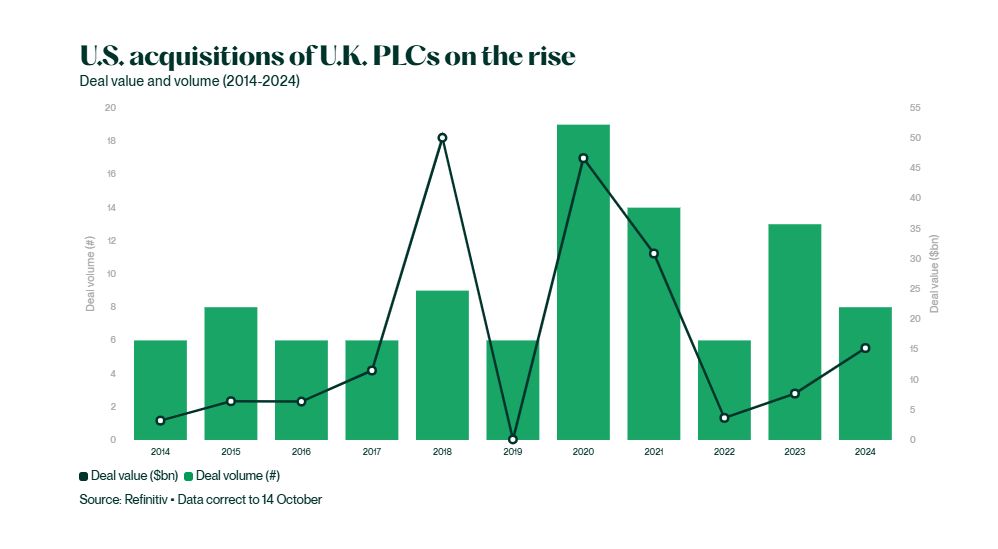U.S. acquisitions of U.K. listed companies have traditionally
been a staple of global deal flow. This year is no exception,
although the volume of attempted bids far outweighs the number of
completed deals. Buyers need to understand the unique features of
the U.K. takeover regime to ensure their transactions succeed.
Transatlantic public M&A involving U.S. bidders and U.K.
targets has long underpinned global deal flow, with U.S.
corporations and private equity sponsors originating more inbound
takeovers of U.K. listed businesses than investors from other
countries. Indeed the size and volume of these deals is often seen
as a key indicator of the strength of the global M&A market,
and of the confidence levels of corporations and their boards to
seek international growth and scale.
So far in 2024 we have seen a return of significant
transatlantic public M&A activity, with acquisitions of U.K.
listed companies by U.S. acquirors worth USD15.2 billion in the
period to mid-October, almost double 2023's annual total of
USD7.7bn. A number of these deals have been competitive, and some
have seen all or part of the consideration made up of shares issued
in a listed U.S. acquiror.

Several factors are driving this uptick in activity. Corporates
have been far more active in what has at times been a private
equity-dominated market in recent years, driven by greater
confidence in their businesses and the broader economic outlook,
the desire for scale and synergies to address higher costs, and a
more favorable financing market. This has been coupled with slight
improvement in private equity deal activity after an extended lull
in 2022 and 2023.
Relative strength of U.S. equity markets makes many inbound
bids attractive
Where deals involve an offer of U.S. listed shares as
consideration, clearly the synergy value is an important component
of the value opportunity presented to the target company's
shareholders. However, key to the narrative has also been the
chance to realize a re-rating of shareholders' equity to
reflect the typically higher multiples that the acquiror's
stock trades at the U.S. market.
This is part of a recent and much broader market theme involving
the relative strength and competitiveness of the U.S. compared to
other jurisdictions, which in some cases has seen companies move
their place of listing to the U.S. outside of an M&A
context.
U.K. takeover rules create a competitive market for
bidders
Bidders have found it hard to execute in 2024, with the number
of approaches made to U.K. targets far exceeding the volume of
announced and completed deals. In many of these cases the
target's board has been robust in its assessment of value, with
a 30%-40% bid premium (historically considered the benchmark) not
enough to obtain a recommendation. At the same time, several deals
have not proceeded on the basis of issues arising in due
diligence.
We have also seen greater competition for U.K. public companies,
with U.S. corporations prepared to engage in the level playing
field the U.K. regime creates for contested takeovers. U.K. boards
are permitted to switch their recommendation to another bidder
during a transaction, so the initial bidder needs to make its
package as attractive as possible, not just in terms of price but
also in relation to certainty and speed of execution.
The price of a target board recommendation is not necessarily as
high as the price required to discourage other bidders from
entering the race. We have seen examples of bidders being pushed to
terms higher than those which may have caused a potential
interloper to think twice about intervening had they been offered
from the outset.
Aspects of U.K. public M&A regime are unique in global
markets
Many aspects of the U.K. regime for public M&A are unique
among the major global financial centers, and certainly compared to
the regulation of U.S. public company transactions.
- Deals are overseen by the Takeover Panel, an organization which
is independent of government and the financial regulator, the
Financial Conduct Authority.
- The Panel has a high degree of discretion to apply the rules of
the Takeover Code in a manner that it considers achieves their
underlying purpose, which at a high level are to "ensure fair
treatment for all shareholders and an orderly framework for
takeover bids".
- The rules themselves are principles-based and not written in
the technical language of legislation.
- The Panel comprises a combination of permanent staff and
M&A practitioners on secondment (mainly from investment banks
and law firms), and is heavily involved in the day-to-day running
of deals.
- Its rules require advisors to consult with the Panel on any
matter of interpretation of the Takeover Code rather than to form
their own view. As a result, many key issues on a deal involve a
real-time discussion with the Panel. The U.S. approach is very
different in this regard, with the SEC's role more focused on
compliance with detailed rules and regulations primarily dealing
with appropriate disclosure.
- The Panel also has authority over certain aspects of a
transaction, such as the circumstances in which a regulatory
condition can be invoked, which in the U.S. are largely a matter of
contract between the parties, and ultimately the courts in the
event of a dispute.
The Panel system of M&A regulation in the U.K. takes some
getting used to for those unfamiliar with the process. However,
parties often recognize the benefits of being able to speak to an
experienced M&A practitioner at the regulator who can provide
certainty and quick decision-making (often 24/7) on a live
issue.
U.K. vs U.S. M&A regimes – key differences
compared
Clearly every transaction is different and expert advice should
be sought in each case. However, we set out below some of the key
differences between the U.K. and U.S. public M&A regimes which
are important to understand before embarking on a takeover of a
U.K. listed company.
| M&A issue |
U.K. regime |
U.S. regime |
|
Leaks
|
- The Panel may require a leak announcement at an early stage if
there is press speculation or an untoward price rise after the
point at which a bid is "actively considered" by the
potential bidder.
- The risk of a leak announcement is heightened on approaching
the target.
- The financial advisor leads engagement with the Panel on
whether a leak announcement is required.
- If it is, the Code imposes a 28-day deadline for the bidder to
announce a firm offer (fully financed, due diligence complete) or
walk away. This can be extended by the target.
- A maximum of six external parties (excluding advisors) may be
brought inside before announcement.
|
- As a general matter, no requirement to disclose approaches and
negotiations in response to inquiries, and therefore most companies
adopt a "no comment" policy in the event of a leak.
- A party may not remain silent about negotiations, however, if
silence would result in a temporally relevant disclosure becoming
inaccurate or misleading.
- Also, "no comment" typically does not work in
response to an official inquiry (e.g. resulting from unusual
trading or market rumors).
- However, stock exchanges will be reluctant to accept "no
comment" in response to an official inquiry.
|
|
Due diligence
|
- Typically more limited than in private and U.S. M&A
deals.
- Any due diligence information provided by the target must also
be given to other potential bidders that may emerge, even if less
welcome, which naturally constrains what information may be
forthcoming.
|
- Similar to the U.K. position, however no rule requiring that
all bidders be given the same due diligence information, even
though the result in practice may be the same.
|
|
Deal protection
|
- The target is prohibited from agreeing most deal protection
measures with a bidder (e.g. break fees, no-shop, matching rights,
etc).
- The target can commit to assist with regulatory clearances, but
the board is otherwise free to withdraw and switch its
recommendation.
- Reverse break fees are seen where there are substantive
regulatory risks and/or bidder shareholder approval is
required.
- Bidders focus on director and shareholder irrevocable
undertakings, price, speed and execution certainty to impose
hurdles for potential interlopers.
|
- Deal protection measures are ubiquitous in U.S. transactions,
which typically have a no-shop covenant, with a "fiduciary
out" – an ability for the board to change its
recommendation and terminate the agreement upon payment of a break
fee (which typically is between 2% and 4% of equity value based on
constraints imposed by fiduciary principles under Delaware law) and
matching rights.
- Some U.S. transactions include a "go shop", which
permits the target company to shop itself to others for an agreed
number of days after signing, typically with a lower break fee
payable if an alternative deal is struck during this period.
- Reverse break fees are common to address substantive regulatory
approval risks. No upper limit on reverse break fees imposed by
applicable law, so on average, amounts tend to be higher than
typical break fees.
- Tender/support/voting agreements with directors and significant
shareholders are common.
|
|
Regulatory conditions
|
- Panel requires all reasonable steps to be taken to satisfy
conditions.
- Panel will not permit a condition to be invoked unless
circumstances are of material significance in context of offer.
Panel will apply this test to a remedy required by a regulator to
the extent known before the long-stop date.
- Target companies typically negotiate contractual commitments to
obtain regulatory clearances, which exist alongside Panel regime,
although litigation is rare.
- Long-stop date is a key focus, in particular whether it should
accommodate a second request/in-depth review notwithstanding
financing cost of longer period.
|
- Unlike in the U.K., the parties are free to agree on conditions
to the transaction by contract and the SEC and courts will not
intervene in what those conditions are.
- Similarly, invocation of a condition is a matter between the
parties (and ultimately the courts if there is a dispute as to
whether it was properly invoked) and not something the SEC is
involved in.
- Similar approach to U.K. around negotiation of contractual
commitments to obtain regulatory clearances and long-stop
date.
- Litigation more common in the U.S.
|
|
MAC and other general conditions
|
- Very difficult to invoke. Bidder can improve ability to invoke
by including specific negotiated conditions and clearly disclosing
to shareholders the circumstances in which bidder would seek to
invoke.
|
- Again, parties are free to agree contractually on the
conditions to the transaction, and the SEC will not get involved.
MAC provisions in the U.S. rarely include specific triggers,
leaving this to the parties' (and courts') interpretation
However, similar to the U.K., the no MAC condition is very
difficult to successfully invoke – a landmark Delaware case
in 2018 marked the first ever successful invocation of a MAC in
Delaware.
|
|
Deal structure
|
- Scheme of arrangement most common structure on recommended
transactions – requires two-limbed shareholder approval: (i)
majority in number; and (ii) 75% by value, in each case of
shareholders voting.
|
- Statutory merger most common structure in friendly
transactions, which requires (in Delaware) the affirmative vote of
a simple majority of the target's outstanding shares to
approve.
- Tender offers are also fairly commonly used in situations where
speed is paramount and the regulatory approval process can be
completed very quickly, as well as in hostile situations.
|
|
Financing
|
- Certain funds required at time of firm offer announcement (full
financing documentation). Financial advisor must provide cash
confirmation statement and will appoint own counsel to verify
source(s) of funds.
|
- No certain funds type rules or cash confirmation as in the
U.K., but rather a matter of contract between the parties.
- Typically acquiror will provide target company with signed debt
commitment letters that, subject to limited customary conditions,
require the lender party thereto to provide the required debt
financing at closing.
|
|
Intention statements
|
- Bidder must disclose intentions for the business, locations,
management, employees and R&D (pre-vetted by Panel before deal
is announced). Panel review after 12 months to ensure
compliance.
|
- No similar requirements in U.S. transactions, though often, as
an IR, PR and retention matter, buyers will explain their plans at
a high level to market the transaction.
|
|
Management incentives
|
- Any post-completion incentives package requires full disclosure
and fairness opinion. Equity arrangements (outside ordinary course
awards) or unusual incentive arrangements can require separate
shareholder vote. Incentive arrangements often deferred until
post-completion.
|
- Disclosure will also be required, but no requirement to obtain
a fairness opinion.
- Certain arrangements may require a shareholder vote, but these
are not that common in the typical U.S. public company transaction
as they are usually handled post-closing once the target company is
no longer public.
- Arrangements with target company management will generally not
be negotiated until key deal terms, including price, have been
agreed.
|
The content of this article is intended to provide a general
guide to the subject matter. Specialist advice should be sought
about your specific circumstances.







